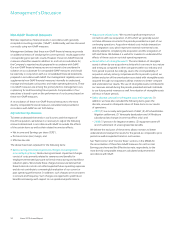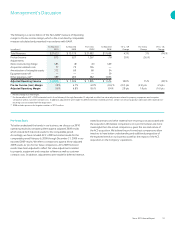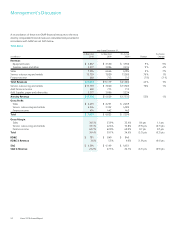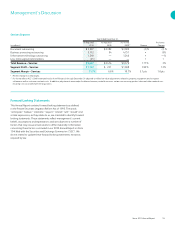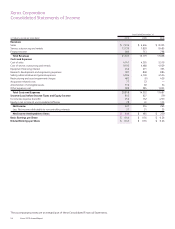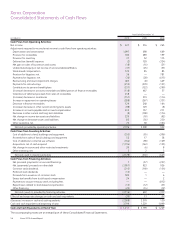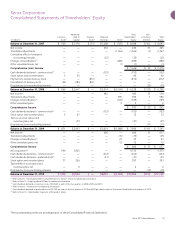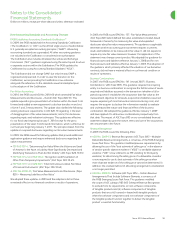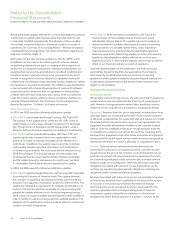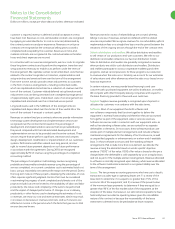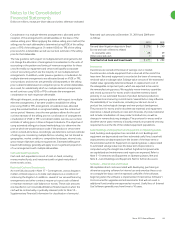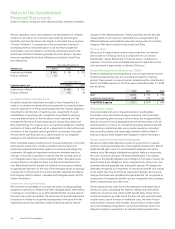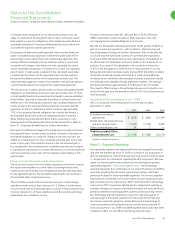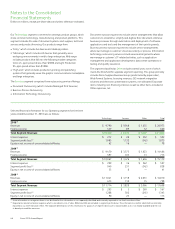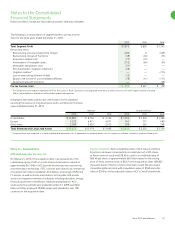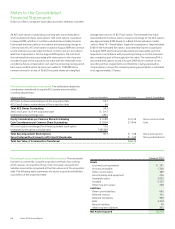Xerox 2010 Annual Report Download - page 61
Download and view the complete annual report
Please find page 61 of the 2010 Xerox annual report below. You can navigate through the pages in the report by either clicking on the pages listed below, or by using the keyword search tool below to find specific information within the annual report.
Notes to the Consolidated
Financial Statements
Dollars in millions, except per-share data and unless otherwise indicated.
59Xerox 2010 Annual Report
New Accounting Standards and Accounting Changes
FASB Establishes Accounting Standards Codification™
In 2009, the FASB established the Accounting Standards Codification
(“the Codification” or “ASC”) as the official single source of authoritative
U.S. generally accepted accounting principles (“GAAP”). All existing
accounting standards are superseded. All other accounting guidance
not included in the Codification is considered non-authoritative.
The Codification also includes all relevant Securities and Exchange
Commission (“SEC”) guidance organized using the same topical structure
in separate sections within the Codification. The FASB updates the
Codification by issuing Accounting Standard Updates (“ASUs”).
The Codification did not change GAAP, but only the way GAAP is
organized and presented. In order to ease the transition to the
Codification, we are providing the Codification cross-reference
alongside the references to the standards issued and adopted prior
to the adoption of the Codification.
Fair Value Accounting
In 2010, the FASB issued ASU No. 2010-06 which amended Fair Value
Measurements and Disclosures – Overall (ASC Topic 820-10). This
update required a gross presentation of activities within the Level 3 roll-
forward and added a new requirement to disclose transfers in and out
of Level 1 and 2 measurements. The update also clarified the following
existing disclosure requirements in ASC 820-10 regarding: i) the level
of disaggregation of fair value measurements; and ii) the disclosures
regarding inputs and valuation techniques. This update was effective
for our fiscal year beginning January 1, 2010 except for the gross
presentation of the Level 3 roll-forward information, which is effective for
our fiscal year beginning January 1, 2011. The principle impact from this
update is to expand disclosures regarding our fair value measurements.
In 2009, the FASB issued the following updates that provide additional
application guidance and require enhanced disclosures regarding fair
value measurements:
FSP FAS 157-4,
• “Determining Fair Value When the Volume and Level
of Activity for the Asset or Liability Have Significantly Decreased and
Identifying Transactions That Are Not Orderly” (ASC Topic 820-10-65)
FSP FAS 115-2 and FAS 124-2,
• “Recognition and Presentation of
Other-Than-Temporary Impairments” (ASC Topic 320-10-65)
FSP FAS 107-1 and APB 28-1,
• “Interim Disclosures about Fair Value
of Financial Instruments” (ASC Topic 320-10-65)
ASU No. 2009-05,
• “Fair Value Measurements and Disclosures (Topic
820) – Measuring Liabilities at Fair Value”
We adopted these updates in 2009 and the adoptions did not have
a material effect on our financial condition or results of operations.
In 2006, the FASB issued SFAS No. 157, “Fair Value Measurements”
(ASC Topic 820) which defined fair value, established a market-based
framework or hierarchy for measuring fair value and expanded
disclosures about fair value measurements. This guidance is applicable
whenever another accounting pronouncement requires or permits
assets and liabilities to be measured at fair value. It did not expand or
require any new fair value measures; however, the application of this
statement may change current practice. We adopted this guidance for
financial assets and liabilities effective January 1, 2008 and for non-
financial assets and liabilities effective January 1, 2009. The adoption of
this guidance, which primarily affected the valuation of our derivative
contracts, did not have a material effect on our financial condition or
results of operations.
Business Combinations
In 2007, the FASB issued SFAS No. 141 (revised 2007), “Business
Combinations” (ASC Topic 805). This guidance requires the acquiring
entity in a business combination to recognize the full fair value of assets
acquired and liabilities assumed in the transaction (whether a full or
partial acquisition); establishes the acquisition date fair value as the
measurement objective for all assets acquired and liabilities assumed;
requires expensing of most transaction and restructuring costs; and
requires the acquirer to disclose the information needed to evaluate
and understand the nature and financial effect of the business
combination. We adopted this guidance effective January 1, 2009
and have applied it to all business combinations prospectively from
that date. The impact of ASC Topic 805 on our consolidated financial
statements depends upon the nature, terms and size of the acquisitions
we consummate in the future.
Revenue Recognition
In 2009, the FASB issued the following ASUs:
ASU No. 2009-13,
• Revenue Recognition (ASC Topic 605) – Multiple-
Deliverable Revenue Arrangements, a consensus of the FASB Emerging
Issues Task Force. This guidance modified previous requirements by
allowing the use of the “best estimate of selling price” in the absence
of vendor-specific objective evidence (“VSOE”) or verifiable objective
evidence (“VOE”) (now referred to as TPE standing for third-party
evidence) for determining the selling price of a deliverable. A vendor
is now required to use its best estimate of the selling price when
more objective evidence of the selling price cannot be determined. In
addition, the residual method of allocating arrangement consideration
is no longer permitted.
ASU No. 2009-14,
• Software (ASC Topic 985) – Certain Revenue
Arrangements That Include Software Elements, a consensus of
the FASB Emerging Issues Task Force. This guidance modified
the scope of ASC subtopic 985-605 Software-Revenue Recognition
to exclude from its requirements (a) non-software components
of tangible products and (b) software components of tangible
products that are sold, licensed or leased with tangible products
when the software components and non-software components of
the tangible product function together to deliver the tangible
product’s essential functionality.



